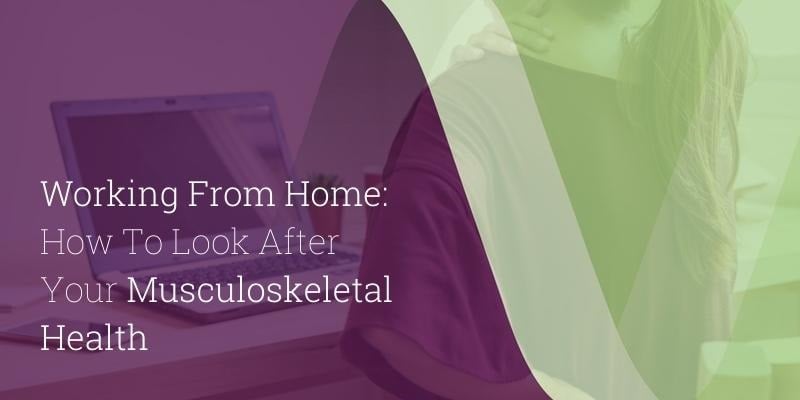
With the new Omicron variant on the rise, many are pushing for another “work from home if you can” approach. Although many workers are now back to the office, the “hybrid” business model seems to be prevalent in many industries. Tom Stukins, Deputy Physiotherapy Manager at New Victoria Hospital, talks about the increased Musculoskeletal risks when working from home and what you can do to prevent them.
How Working From Home has affected your MSK health
On March 23rd 2020 (when the first full lockdown was announced) everyone’s lives dramatically changed overnight.
For many, being told to stay at home meant that they were simply unable to work. But for millions of people in the UK it meant that they simply moved their ‘work office’ into their ‘home office’ which for some was the kitchen table or breakfast bar, the lounge sofa or dining room table, sharing it with their partners and or children all faced with the same predicament.
It is estimated that in 2020 71% of the UK work force was working from home, musculoskeletal problems were among the most common reported ailments.
Spinal pain is the area that any outpatient physiotherapist will treat more than any other during the course of a day, a week, a month but there is no doubt that multiple Covid lockdowns during the last 18 months have caused a significant rise in postural lower back pain and neck pain syndromes.
Under normal circumstances people working at desks at a dedicated work or home station have the opportunity to adapt the environment to suit their own needs. This can be modified over a period of time to ensure that the spine is positioned and supported in its optimum position.
However, when change is thrust upon us, as was the case in March 2020, there is no time or opportunity to prepare for a whole new way of working in a whole new environment. In addition to this the availability of ergonomic equipment to purchase was scarce due to a sudden and dramatic increase in demand.
Consequently the first lockdown March 2020 created a ‘perfect storm’ of a poorly prepared workforce using sub-optimal desk set-ups, leading to altered and abnormal postures for prolonged periods of the day which caused a lot of people to become stiff, sore and painful in the neck or lower back.
Prolonged bad posture activates pain sensors
When you slouch or slump for prolonged periods the effect on the spine can be quite wide reaching. Under normal circumstances the strong and extensive spinal muscles hold the back upright keeping the vertebrae aligned to keep the forces of body weight and gravity evenly distributed so the joint surfaces, intervertebral discs, ligaments and other soft tissue structures remain in their ‘comfort zone’. As long as ‘good posture’ is interrupted with regular breaks away from the desk or frequent stretches to avoid muscular fatigue the spinal structures can cope pain free.
However, when the spine is kept in a slumped position for long periods of time the stresses on the joint surfaces and soft tissues becomes overwhelming. When the ligaments are kept under abnormal amounts of tension they become stretched to an abnormal length which means they no longer provide structural support to the spine.
If you keep your muscles in in a lengthened state for prolonged periods they too become over stretched which has the effect of making them weaker due to a change in their length tension relationship. This not only leads to pain as with the ligaments but also means that if we persist in adopting poor posture the muscles become progressively weaker and provide less and less support to our spine.
When you slump, the disc wall becomes stretched at the back, which may cause pain in the first instance but is likely to increase the risk of disc injury during other more physical activities. The facet joint surfaces when placed under uneven pressure distribution causes specific areas to be compressed so that the water content of the articular cartilage is squeezed out and the synovial fluid distribution is affected leading to altered joint biochemistry which becomes another source of pain.
How to look after your back if you’re working from home
If you are still working from home every day or even a few times a week, you can make the most of the Christmas holidays to enhance your work station at home and adopt a few changes that will improve your posture and overall MSK health.
My top tips for beating postural back pain and preventing MSK risks are:
- Take the time to set up your desk and work environment.
- Sit upright!
- Aim for 90 degrees at the ankle, knees and hips
- Screen height should be at eye level: use a laptop or screen riser if necessary
- The mouse and keyboard should be within easy reach with your elbows at you side, not reaching out in front
- Consider an external mouse and keyboard if you use a laptop
- Use a height adjustable chair
- Take regular breaks away from your desk: get up every 30-40 minutes to stretch your legs, get a drink or some fresh air
- Do regular seated exercises similar to those done on a long haul flight
- Use a posture trainer wearable device to monitor your spinal angle and vibrates to tell you when to sit up
- Stay well hydrated
- Have a good, regular exercise regime including strength and cardiovascular elements
If you would like to discuss any back or neck issues with our Physiotherapists at New Victoria Hospital or improve your posture, you can call us on 020 8949 9040 or fill in our online form












